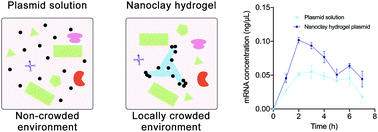Creating a locally crowded environment with nanoclay hydrogels for cell-free biosynthesis†
Abstract
In living cells, the exceptionally high local concentration of macromolecules, or “locally crowded environment,” could affect many aspects of cellular function. Exploration of the locally crowded environment can improve the understanding of living cells and advance the study of artificial cells. In this paper, nanoclay combined with gene templates is used to simulate the locally crowded environment in a cell-free system, ultimately to explore its effects on protein expression. The adsorption effect can immobilize the plasmid on the nanoclay surface, thereby achieving a higher local concentration in the cell-free system. A closer proximity of genes could result in an increase in the protein production of cell-free systems by 1.75 times. Besides, the kinetics of the nanoclay in the cell-free system was analyzed, and the results showed that the genetic transcription level involved in cell-free reactions was significantly improved. This study confirms that a locally crowded environment created by the nanoclay can achieve high protein expression in a cell-free system and help promote the process of transcription and translation. Application of the nanoclay in the cell-free system demonstrates the significance of applying nanomaterials in biological and biomedical fields and provides technical support for the study of the locally crowded environment.



 Please wait while we load your content...
Please wait while we load your content...